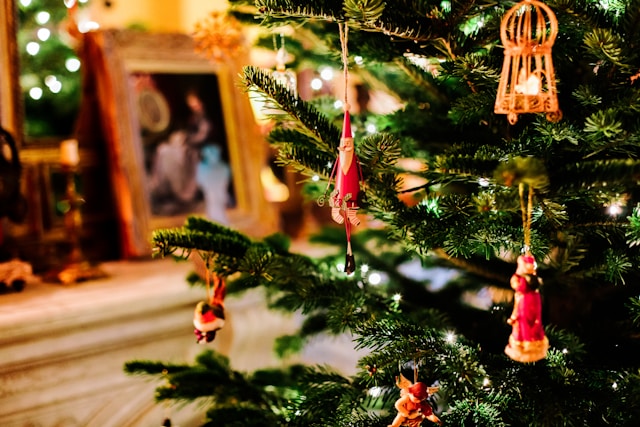Christmas Tree Farming – In less than 14 days, we would enter into the last four months of year, ushering us into the season of festivities. As the holiday season draws near, the environmental impact of Christmas trees often becomes a hot topic. While worries about deforestation and carbon footprints are important, it’s also worth highlighting the green benefits of growing Christmas trees. They can actually be a positive force for the environment when managed sustainably. Growing Christmas trees can be very sustainable and great for the earth—busting that myth that most people probably still believe.
Christmas Tree Farming: An Industry
Christmas tree farming is an agricultural industry unto itself, with trees cultivated specifically to be harvested and sold during the holiday season. These farms are not involved in logging operations that contribute to deforestation; a regenerative cycle always ensures that trees are continuously being re-planted. This consistency ensures that the land remains forested, therefore fostering the overall vitality of the ecosystem.
Life History of a Christmas Tree
Christmas trees typically require 7 to 10 years before they attain the commercially acceptable age. During this time, they play a huge role in carbon sequestration, help stabilize soil, and create wildlife habitats. The farms also act as a buffer against urbanization, maintaining green spaces and preserving the rural landscape.
Environmental Benefits of Christmas Tree Farming
Carbon Sequestration: A very important environmental benefit of Christmas tree farming is carbon sequestration. Trees, in their normal state, absorb carbon dioxide (CO2) from the atmosphere and store it as carbon in their biomass. A single acre of Christmas trees can sequester one ton of CO2 every year. Considering the vast land used for Christmas tree farming, the accumulated effect on carbon abatement is really significant.
Soil and Water Conservation: The root systems of Christmas trees help reduce soil erosion by holding the soil together. This is particularly important on sloping terrains, where erosion could lead to the loss of fertile soil and increased sedimentation in adjacent watercourses. Additionally, these trees enhance water infiltration, reducing surface runoff and helping maintain the local water table.
Christmas tree farms often act as refuges for other species. The trees provide cover for birds, insects, and small mammals. Farmers frequently leave strips of grass and hedgerows between tree rows, providing further habitat diversity. Such farms can function as wildlife corridors, connecting fragmented habitats and supporting species that thrive in forested environments.
Economic and Social Benefits of Christmas Tree Farming
Rural Employment: Christmas tree farming provides jobs in planting, caring for, harvesting, and selling trees. It helps to support rural economies and provides for many families, especially in areas where agricultural work may be limited. The seasonal nature of the work also offers a reliable source of income during the winter months.
Agroforestry Incorporation: Many Christmas tree farms utilize agroforestry integration. This means that Christmas tree production is mixed with other crops or livestock. This integrated approach allows the most efficient use of farm acreage while also increasing the resilience of the farm. Farmers might plant cover crops between tree rows to increase soil health or keep livestock that feed on the undergrowth.
Environmental Concerns
Pesticide Use: One of the biggest concerns with growing Christmas trees is the use of pesticides. However, many farms are switching to integrated pest management (IPM) plans in an effort to limit the number of chemicals used.
Real vs. Artificial Trees: The argument of whether to use real trees or artificial Christmas trees usually centers around the environmental impact / climate. Real trees are biodegradable and can be mulched or composted, whereas artificial trees are usually made out of non-biodegradable plastics and consume a great amount of energy for their production. Over time, the real tree’s effect on the environment is arguably much less significant than that of an artificial one. Eco-friendly Christmas tree farming
Less than 14 days till the last four months of the year, which bring festivities. Christmas tree environmental impact is a big topic as the holidays approach. Growing Christmas trees has environmental benefits, despite concerns about deforestation and carbon footprints. They can help the environment if maintained sustainably. Contrary to popular belief, growing Christmas trees is sustainable and environmentally friendly.
How to Grow Your Own Christmas Tree: A Comprehensive Guide
Growing your own Christmas tree is a rewarding and sustainable choice that enhances the festive spirit of the season. This guide provides a detailed approach to selecting, planting, and nurturing your Christmas tree, ensuring it flourishes into a magnificent centerpiece for your holiday celebrations.
Choosing the Right Christmas Tree Species
Selecting the appropriate species is crucial for a successful Christmas tree cultivation. Here are the top varieties suited for home growing:
Fraser Fir (Abies fraseri)
- Characteristics: Dense, pyramidal shape with strong branches and needle retention.
- Climate: Prefers cool climates and well-drained soil.
- Growth Rate: Moderate, reaching up to 7-10 feet in height in 7-10 years.
Noble Fir (Abies procera)
- Characteristics: Blue-green needles, sturdy branches, and a symmetrical form.
- Climate: Thrives in cooler climates with moist, well-drained soil.
- Growth Rate: Slow to moderate, achieving 6-9 feet in 8-12 years.
Blue Spruce (Picea pungens)
- Characteristics: Silvery-blue needles and a conical shape.
- Climate: Adapts to a range of climates but prefers cooler regions.
- Growth Rate: Moderate, growing to 8-12 feet in 7-10 years.
Preparing the Soil and Site
Soil Requirements
- pH Level: Aim for a pH between 6.0 and 7.0.
- Drainage: Ensure the soil is well-drained to prevent root rot.
- Fertility: Enrich the soil with organic matter, such as compost or well-rotted manure.
Site Selection
- Sunlight: Choose a location with full sunlight to promote healthy growth.
- Spacing: Allow ample space between trees to ensure proper air circulation and reduce disease risk.
Planting Your Christmas Tree
When to Plant
- Timing: Plant your tree in early spring or late fall when temperatures are cooler and soil moisture is adequate.
Planting Process
- Digging the Hole: Dig a hole twice as wide and slightly deeper than the root ball.
- Preparing the Tree: Remove the tree from its container and gently loosen any encircling roots.
- Placing the Tree: Position the tree in the center of the hole, ensuring the top of the root ball is level with the surrounding soil.
- Backfilling: Fill the hole with soil, packing it gently to eliminate air pockets.
- Watering: Water thoroughly to settle the soil and encourage root establishment.
Caring for Your Christmas Tree
Watering
- Frequency: Water the tree regularly, especially during dry periods. Keep the soil consistently moist but not waterlogged.
- Method: Use a soaker hose or drip irrigation to provide deep, even moisture.
Fertilizing
- Type: Apply a balanced, slow-release fertilizer in early spring.
- Application: Follow the manufacturer’s instructions to avoid over-fertilization, which can harm the tree.
Pruning
- Timing: Prune annually in late winter or early spring before new growth begins.
- Technique: Remove any dead, damaged, or crossing branches to maintain a healthy structure and encourage a dense canopy.
Protecting Your Christmas Tree
Pest and Disease Management
- Common Pests: Watch for aphids, spider mites, and scale insects. Treat infestations with appropriate insecticides or natural predators.
- Diseases: Prevent fungal diseases like needle cast by ensuring good air circulation and avoiding overhead watering.
Winter Protection
- Mulching: Apply a layer of mulch around the base of the tree to insulate the roots and retain soil moisture.
- Covering: In extreme cold, use burlap or frost cloth to protect young trees from harsh winter conditions.
Harvesting and Preparing for the Holidays
Harvesting
- Timing: Harvest your tree in late fall or early winter when it reaches the desired height and shape.
- Method: Use a saw to cut the tree at the base, and ensure a clean cut to minimize damage.
Preparing for Display
- Trimming: Trim the base of the trunk to improve water absorption and extend the tree’s freshness.
- Watering: Place the tree in a stand with water immediately after cutting to maintain hydration.

